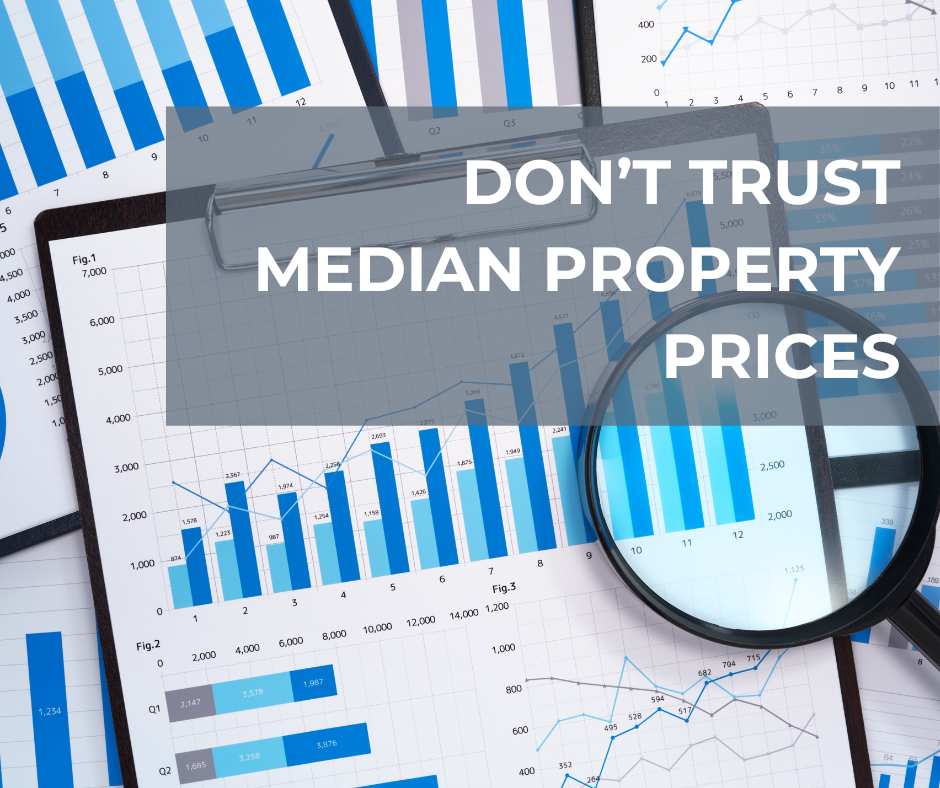What is a median price?
The median property price is a statistical measure that represents the middle value of a dataset when it is organised in ascending or descending order. For real estate, the median property price is often used to provide a representation of the typical value in a location (suburb, city, region, state, even the country), and it is widely used in media commentary.
As an example, if you have a list of home prices, the median price would be the price at which half of the homes are priced lower and half are priced higher when arranged in numerical order.

This is in contrast to the average price, which is calculated by adding up all the prices and dividing by the number of properties.
Medians are generally reported separately by UNITS and HOUSES.
Limitations of the median
While the median can be a useful measure, it also has its limitations, and there are various downsides to relying solely on it when assessing property data:
- Limited Information: The median provides information about the middle value but doesn't consider the entire distribution of values. It doesn't account for the variability or the range of prices within the dataset. This means that two datasets with the same median could have very different distributions (see the image and explanation below for an example of this).
- Lack of Weighting: The median treats all values equally, regardless of their frequency or weight. In situations where certain property prices are more common or represent a larger portion of the market, the median may not accurately reflect the typical property price.
- Sensitivity to Sample Size: The median may be sensitive to changes in the number of property sales. Adding or removing extreme values can impact the median, and in small datasets, this sensitivity can be more pronounced. For this reason some property tools do not provide month by month analysis of suburbs that have small datasets (i.e. small numbers of sales per month). But some data providers will provide medians regardless of the number of sales and investors should be cautious about relying on such data.
- Ignoring Outliers: While the median is less influenced by extreme values than the average, it completely ignores the information provided by outliers. In some cases, outliers may be important indicators of unique characteristics or issues within the property market.
- Different Algorithms: Different data providers (i.e. Corelogic, Domain, ABS etc) will all have their own approach to working out the median. Some may also try to eliminate the issues with medians. For property buyers this can represent a challenge as you may be assessing inconsistent data.
- Doesn't Consider Property Characteristics: The median only takes into account the numerical values of property prices. It doesn't consider other important factors such as property size, location, amenities, or condition, which are crucial in assessing the overall value of a property.
- Incorrect Categorisation of Property Type. Sometimes data sets have errors. A common one I see in real estate data is a property classified as a HOUSE when they are really not a "house". Errors in data classification will compromise any statistical assessment including the median.
For further discussion on the limitations of the median in real estate, click here.
WICKHAM NSW - Median analysis and example
The median can be deceiving
The first column in the table below is a list of all HOUSE sales in the Newcastle suburb of Wickham, for the 12 months to March 2024.
The 2nd and 3rd columns are other data sets, made up to demonstrate how medians can be deceiving some times.

ANALYSIS
- Compare the Wickham data to Sample A -
- Exact same median of $920,000.
- The average sale for Sample A though is nearly $400,000 more than the median.
- The low-end sales were the same but there were a lot more high end sales in Sample A. The data here is absolutely possible and "skewed" to the higher end.
- Compare the Wickham data to Sample B -
- The median in Sample B is only $700,000, $220,000 less the median for Wickham.
- But the average sale price is nearly identical.
- The highest sale and lowest sale were also identical. So here you can see that the distrubution of sales in between the minimum amd maximum in Sample B was very different.
This analysis is designed to demonstrate how the individual sales (in a given time period) and distribution of those prices play a HUGE role in the median. It also shows that the median is NOT always a great indicator of property price within a suburb.
Large drops or increases in the median can occur but are NOT always right
Below is a screenshot of the 5 year median price trend for Wickham, courtesy of realestate.com.au (you can access this graph here albeit the data may be different to below, which was correct as at early March 2024).
Note the "apparent" 12.5% drop in median price in 1 month. To the untrained eye this may cause alarm. From the theoretical explthough, anation above you should be able to understand that this can certainly happen when tracking medians, and is not an error in any way.
But, whilst this data may be 100% accurate, property prices in Wickham did NOT drop 12.5% in between Sep 23 and Oct 23. The median and the graph below therefore is NOT a true reflection (in my opinion) of Wickham market for houses.
4 tips to overcome the limitations of the median
To overcome these limitations:
- Educate Yourself. First you need to educate yourself; understand what the median is and its limitations. And if you are looking at a data set, be sure to question it or talk to someone who understands it.
- Alternate Approach. Consider using an alternative approach to property values (see below).
- More Data. Use a combination of statistical measures. So if you do rely on median also consider the average, range, and other relevant metrics.
- Use Local Experts and other Factors. Additionally, consider qualitative factors and seeking professional local advice can provide a more comprehensive understanding of the property market you are interested in.
There is also specialist software available to professionals that can help to provide a different (and I believe better) perspective on pricing. One such approach is using Typical Price and data fitting. Below is a graph from HtAG software (which uses Typical Price) for Wickham NSW which shows a much smoother curve for the past 12 months.
As I am sure you will agree this smoother graph looks more normal and believable and much less eratic than the median as above.

Conclusion
In conclusion, while median property prices serve as a common metric to gauge the typical value within a location, it comes with significant limitations. The median fails to capture the entire distribution of property values, lacks consideration for outliers, and overlooks crucial property characteristics. Variability in calculation methods by different data providers adds another layer of complexity for property buyers. The Wickham NSW example illustrates how medians can be misleading, with instances of identical medians accompanied by substantial differences in actual property values.
To navigate these limitations, individuals are advised to educate themselves on the shortcomings of median data, explore alternative approaches, incorporate additional statistical measures, and seek guidance from local experts while considering qualitative factors. Utilising a different apprach, such as Typical Price and data fitting, can provide a more nuanced perspective on property pricing, helping investors and owners make better decisions.
About the Author – Nigel Watts
Nigel was born in Newcastle and has lived in the area in a variety of suburbs for over 30 years. As the co-founder of Niva Property, Nigel helps owner occupiers and investors looking to buy quality property in the Newcastle and Lake Macquarie regions.
Nigel lives in the blue-chip Newcastle location of Merewether. As a property investor, Nigel has also built a multi-million dollar portfolio in multiple states. He has experience with new house builds, off-the-plan, buying existing properties, townhouses and houses. He is also an avid renovator and loves to design and build projects to see them through from conception to finalisation.
Nigel has also spent over 18 years helping construction companies to systemise and streamline their construction estimating, and help government bodies all over the world to implement technology to assist with valuation of infrastructure assets. This estimation, construction and valuation experience was gained in buildings, landscaping, civil works and utilities, and he uses this in his every day work to help when assessing property assets for his clients.
Nigel is also member of the Property Investment Professionals of Australia (PIPA).
Get in contact with Nigel now to see how he can help you in your next property acquisition.







